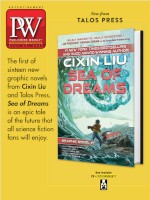In Beasts Before Us (Bloomsbury Sigma, Sept.), paleontologist Panciroli sheds light on discoveries in evolution.
What got you interested in paleontology?
Like everyone, as a child, I did go through a period of absolutely loving dinosaurs and other kinds of fossils, but I then moved on to other things. Much later, at university, I started learning about environmental science and ancient climate change. It was then that I came to love the very, very ancient world, and rediscovered that childhood delight in fossils. I shifted to mammal evolution after having an opportunity to work on my master’s with an amazing mammal paleontologist, Dr. Christine Marie Janis, one of the leaders in her field.
Could you expand upon your remark in the book that mammals “ruled the Earth when dinosaurs weren’t even a twinkle in the planet’s eye”?
They were the predecessors of the furry creatures that we think of as mammals, and they filled all the most exciting niches—giant herbivores; huge, fast predators with saber teeth. There were diggers, there were climbers. They were doing all the interesting things in the world, and this wasn’t just a little bit before dinosaurs—it was a good 50-plus million years before dinosaurs appeared. I think a lot of people don’t know that the Permian, the time period when this happened, was a heyday for these proto-mammals.
What did you encounter in your work that was the most unexpected?
Something that consistently surprises me is what technology can do now—I now work a lot with X-ray and CT scanning, including something called synchrotron, which is like CT scanning on steroids. It’s the most powerful way to look inside bones and teeth at the structures of how they’re made. We’re looking at stuff that’s as small as a bacterium, and I find that pretty mind-blowing, that not only can we determine that this animal died 200 million years ago, but we can look at its teeth and find out how old it was, based on the rings in the teeth—like counting tree rings.
In recent years, museum displays about fossils are much more equivocal about what prehistoric animals were like. Why?
We’ve had a tendency in the past to be much more absolute about what we know in communicating with the public. We try now to be more careful about the discoveries we make—science isn’t, of course, about finding the “right answer,” but is a constant process of refining what we understand about the world. You ought to be concerned to not think that you’ve got the right answer.



 Volume 268
Issue 28
07/12/2021
Volume 268
Issue 28
07/12/2021





